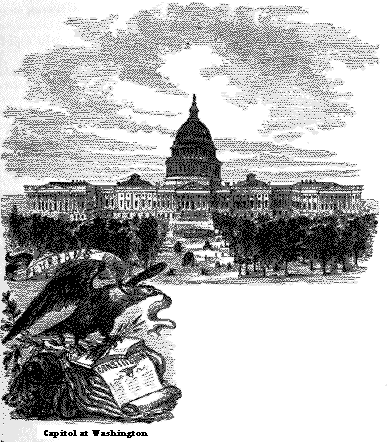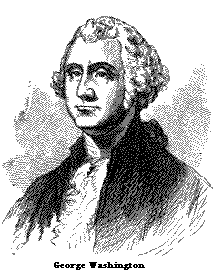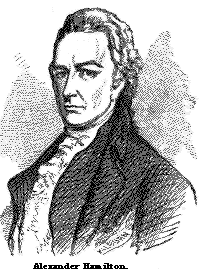Resource Center OLLibrary
|
156 |
|
ANALYSIS.
PERIOD V.--NATIONAL DEVELOPMENT.
Chapter 1.--Washington's Administration, p. 157.
Chap II.--Adams's Administration, p. 163.
Chap. III.--Jefferson's Administration, p. 165.
Chap. IV.--Madison's
Administration.
 I.
From the Beginning of the Administration to the Declaration of War
with
I.
From the Beginning of the Administration to the Declaration of War
with
Great Britain, p. 169.
II. From the Declaration of War to the Battle of Plattsburg. War
chiefly
offensive, p. 171.
III. From the Battle of Plattsburg to the Close of the War. War
chiefly
defensive, p. 184.
IV. From the Close of the War with Great Britain to the Accession
of Monroe,
p. 189.
Chap. V.--Monroe's Administration, p. 190.
Chap. VI.--John Quincy Adams's Administration, p. 193.
Chap. VII.--Jackson's Administration, p. 195.
Chap. VIII.--Van Buren's Administration, p. 201.
Chap. IX.--Harrison's and Tyler's Administrations, p. 203.
Chap. X.--Polk's
Administration.
 I. From
the Beginning of the Administration to the Declaration of War
with
I. From
the Beginning of the Administration to the Declaration of War
with
Mexico, p. 207.
II. Plan of Operations. Operations of the Army under Taylor, p.
211.
III. Conquest of New Mexico and California, p. 213.
IV. Operations of the Army under Scott.--Peace, p. 214.
V. From the Close of the War with Mexico to the Accession of
Taylor, p. 218.
Chap. XI.--Taylor's and Fillmore's Administrations, p. 219.
Chap. XII.--Pierce's Administration, p. 222.
Chap. XIII.--Buchanan's Administration, p. 224.
Chap. XIV.--Condition of the United States at the Close of this Period, p. 230.
![]() Chronology,
p. 233.
Chronology,
p. 233.
PERIOD V.
DISTINGUISHED FOR NATIONAL DEVELOPMENT.
EXTENDING FROM THE INAUGURATION OF WASHINGTON,
IN 1789, TO THE
INAUGURATION OF LINCOLN, IN 1861.

CHAPTER I.
WASHINGTON'S ADMINISTRATION.1 1789-1797.
1. Washington was
inaugurated president of the United States, April 30, 1789, in
New York. The oath of office2 was administered in the
presence of both Houses of Congress,3 and a vast
concourse of spectators.4
2. The first duty of Congress was to provide a
revenue5 for the support of government. For this
purpose duties were laid on imported merchandise and on the
tonnage of vessels.
1 See Appendix, p. 19. 2 See Appendix, p. 13, ¶ 8, Sec. I., Art. II., Const. U. S.
3 See Appendix, p. 8, Sec. I; ¶ 1, Sec. II.; and p. 9, ¶ 1, Sec. III., Art. I., Const. U. S.
4 The ceremony was performed in the open gallery of the old City Hall, repaired and renamed Federal Hall, fronting on Wall Street, on the site of the present Custom-House. The oath was administered by Robert R. Livingston, Chancellor of the State of New York.
5 See Appendix, p. 10, ¶ 1, Sec. VII,. and ¶ 1, Sec. VIII., Art. I., Const. U. S.
QUESTIONS. -- 1. When and where was Washington inaugurated? 2. What was the first duty of Congress? What was done to provide a revenue?
14
|
158 |
|
Three executive departments1
were created, styled Department of Foreign Affairs (afterwards
Department of State), of War, and of the Treasury. The heads of
these departments were styled  Secretaries,
who, with the Attorney-General, constituted a council, called the
president's Cabinet2
Secretaries,
who, with the Attorney-General, constituted a council, called the
president's Cabinet2
3. A national
judiciary,3 also, was established, consisting of
a Supreme Court, and Circuit and District Courts.
The Supreme Court had one chief
justice and five associate justices. District courts were to
consist of one judge in each state; circuit courts of two justices
(afterwards one) of the Supreme Court, and the judge of the
district in which the court might be held. This system has
remained nearly the same till the present time. John Jay
4 was the first chief justice.
4. After the adjournment of
Congress (September 29, 1789), Washington made a tour
through the Eastern States. In the spring of the next year he made
a similar tour through the Southern States. Everywhere he was
received with the greatest enthusiasm.
5. On the reassembling of Congress
(January, 1790), the secretary of the treasury, Alexander
Hamilton,5 in accordance with a resolution of the last
session, submitted a plan for maintaining the public
credit. Agreeably to his recommendation, measures were taken
to pay the foreign and domestic debts of the United States,
amounting to fifty-four millions of dollars, and to assume the
debts of the states, contracted during the Revolutionary War,
estimated at twenty-five millions. These
1 See Appendix, p. 11, ¶ 18, See. VIII., Art. I.. and p. 13, ¶¶ 1, 2, Sec. II., Art. II., Const. U. S.
2 Tito Postmaster-General was made a cabinet officer at a later period. The Department of the Navy (see p. 164, ¶ 2,) and that of the interior (see Appendix p. 20,) have since been added.
3 See Appendix, p. 13, Sec. 1, Art. III., and p. 10, ¶ 9, See. VIII., Art. I., Cons. U. S.
4 See p. 162, ¶ 14, and notes 2, 3. 5 See p. 150, ¶ 4, and p. 167, ¶ 8.
QUESTIONS. -- What executive departments were created? What were the heads of these departments styled? Who constituted the president's cabinet? 3. Of what was the national judiciary made to consist? -- What is said of the Supreme Court? Of the District courts? Of the Circuit courts? 4. What is said of Washington's tours? 5. On the reassembling of Congress what plan was submitted by Hamilton? What measures were taken in accordance with this plan?
|
|
159 |
measures, the credit of which is due chiefly to
Hamilton,1 gave great confidence in the stability and
integrity of the government, and laid the foundation of that
unrivalled prosperity upon which the United States immediately
entered.
To the assumption of the foreign debt
there was no opposition; but the assumption of the  domestic
debt, and the full payment of the state debts, were strongly
opposed, on the ground that many of the original holders of the
securities would receive no benefit, having been obliged, in their
poverty, to sell them to speculators for two or three shillings on
the pound.
domestic
debt, and the full payment of the state debts, were strongly
opposed, on the ground that many of the original holders of the
securities would receive no benefit, having been obliged, in their
poverty, to sell them to speculators for two or three shillings on
the pound.
6. A national
bank2 (1791) and a mint3 (1792),
both located at Philadelphia, were also established during
Washington's first term of office. New York was only temporarily
the capital of the country. At the second session of
Congress4 an act was passed fixing the seat of
government, for ten years, at Philadelphia, and after that,
permanently on the Potomac. Under this act a tract of land ten
miles square was ceded by Maryland and Virginia, and called the
District of Columbia,5 and a capital city was
laid out, and named Washington.6
7. An Indian war
broke out in 1790, on the north-western frontier, ![]() which
was not brought to a close till 1795, when, by treaty, the Indians
ceded to the United States a vast tract of country in the
North-west Territory, embracing more than half of the State of
Ohio and part of Indiana.
which
was not brought to a close till 1795, when, by treaty, the Indians
ceded to the United States a vast tract of country in the
North-west Territory, embracing more than half of the State of
Ohio and part of Indiana.
1 Said Daniel Webster, in deserved tribute to the ability of Hamilton, "He smote the rock of the national resources, and abundant streams of revenue burst forth. He touched the dead corpse at public credit, and it sprang upon its feet."
2 The capital stock was ten millions of dollars, and the charter was to expire in 1811.
3 see Appendix p. 10, ¶ 5, Sec. VIII., Art. I., Const. U. S. Branch mints have since been established at New Orleans; Charlotte, North Carolina; and Dahlonega, Georgia -- all in 1835; at San Francisco in 1852; at Denver, Colorado, 1862; at Carson City, Nevada, 1863, and an assay office at New York city, in 1853. 4 See Appendix, p. 8, note 1.
5 See Appendix, p. 11, If 17, Sec. VIII., Art. I., Const. U. S. The part of this District on the Virginia side of the Potomac, containing forty square miles, has been ceded back to that state.
6 The seat of government was transferred from Philadelphia to Washington in 1800.
QUESTIONS. -- Effect of these measures? -- What is said of the assumption of the foreign debt? Why were the assumption of the domestic debt and the full payment of the state debts opposed? 6 When and where were a national bank and a mint established? What act was passed for fixing the seat of government? What was done under this act? 7. When and where did an Indian war break out? When was it brought to a close? What territory did the Indians cede?
|
160 |
|
On the breaking out of
hostilities, the president attempted to restore peace by
negotiation. Failing in this, he despatched General Harmar
to reduce the hostile tribes to submission. This general came to
an engagement with the Indians near Chillicothe, in which he was
routed, with considerable loss. The command was then given to
General St. Clair, governor of the North-west Territory,
who, with a force of near two thousand men, marched from Fort
Washington, now Cincinnati, September, 1791, into the Indian
country, and, November 4, was surprised and defeated with the loss
of six hundred men killed. General Wayne1 was
appointed to succeed St. Clair, and at the head of about three
thousand men, he gained a complete victory over the hostile
tribes, on the Maumee, August 20, 1794, and compelled them to sue
for peace.
![]() 8.
During Washington's first term, Vermont2 and
Kentucky3 were admitted into the Union as
states; the former in 1791, the latter the next year.
8.
During Washington's first term, Vermont2 and
Kentucky3 were admitted into the Union as
states; the former in 1791, the latter the next year.
Vermont was settled at a much
later period than any other of the Eastern States. The oldest
![]() English
settlement is Brattleboro', where a fort was erected in
1724. For many years, New York and New Hampshire laid claim to the
territory; but New Hampshire surrendered her claim, and in 1790
the inhabitants purchased the interest of New York.
English
settlement is Brattleboro', where a fort was erected in
1724. For many years, New York and New Hampshire laid claim to the
territory; but New Hampshire surrendered her claim, and in 1790
the inhabitants purchased the interest of New York.
Virginia had previously exercised jurisdiction
over Kentucky, and in ![]() 1776
erected it into a county. The territory was early known to the
Indian traders. The first permanent settlement was made in 1775,
by Daniel Boone and others, on the south side of the Kentucky. To
this settlement was given the name of Boonesboro'. James
Harrod, another bold backwoodsman, founded Harrodsburg,
about the same time. During the Revolutionary War, the inhabitants
suffered severely from the Indians, incited by agents of the
British government.
1776
erected it into a county. The territory was early known to the
Indian traders. The first permanent settlement was made in 1775,
by Daniel Boone and others, on the south side of the Kentucky. To
this settlement was given the name of Boonesboro'. James
Harrod, another bold backwoodsman, founded Harrodsburg,
about the same time. During the Revolutionary War, the inhabitants
suffered severely from the Indians, incited by agents of the
British government.
9. The measures of the
administration caused party lines to be distinctly drawn.
Of one party, called the Republican party, Jefferson,
secretary of state, and Randolph, attorney general, were the
acknowledged leaders. Hamilton, secretary of the treasury, and
Adams, the vice-president, were at the bead of the other party,
called the Federalist party. On the meeting of the
electors, in the autumn of 1792, Washington was again, however,
their unanimous choice for president, and Adams was
reëlected vice-president.
1 See p. 125, ¶ 15, and p. 135, ¶ 7.
2 The name was derived from the French words vert, green, and mont, mountain. Vermont was named from the Green Mountains, its principal range.
3 The name Kentucky means the dark and bloody ground -- a name that that region earned from the aborigines, on account of the savage warfare of which it was the scene.
QUESTIONS. -- Give a more particular account of this war. 8. What states were admitted to the Union during Washington's first term of office? -- What can you tell of the early history of Vermont? Of Kentucky? 9. What is said of party lines? Name the two parties and their leaders. Result of the next presidential election?
|
|
161 |
10. In the early part
of Washington's second term, the United States came near being
drawn into a war with Great Britain, as an ally of France; but the
firmness of Washington preserved the neutrality of the
nation.
The French Revolution, then in progress,
was remarkable for its political changes and its sanguinary
violence. Monarchy had been abolished, Louis XVI. had fallen by
the guillotine, a republic had been proclaimed, and the National
Convention of France had made a proclamation of war against
England, Holland, and Spain. These events excited the deepest
interest in the United States. A large majority of the people,
grateful for the aid of France in the American Revolution,
fervently desired the success of the French Republic. The
president, however, issued a proclamation of
neutrality.1
11. The summer of 1794
was signalized by an insurrection in the western counties of
Pennsylvania, commonly known as the Whiskey ![]() Insurrection.
It had its origin in dissatisfaction with a law of Congress which
imposed a duty upon spirits distilled in the United States. It was
quickly suppressed by the federal government.
Insurrection.
It had its origin in dissatisfaction with a law of Congress which
imposed a duty upon spirits distilled in the United States. It was
quickly suppressed by the federal government.
Strong opposition to the law was early
manifested, and armed resistance was Made to the revenue officers
while in the discharge of their duty. The president issued his
proclamation, commanding the insurgents to disperse; and this not
having the desired effect, he ordered out a body of Militia, on
whose approach the insurgents laid down their arms, and solicited
the clemency of the government.
12. The same year a law
was passed prohibiting the fitting out of ships in the United
States for supplying any foreign country with Slaves. ![]() Congress
did at this time all it constitutionally could to suppress the
slave trade. It could not stop the importation of slaves
till 1808.2
Congress
did at this time all it constitutionally could to suppress the
slave trade. It could not stop the importation of slaves
till 1808.2
An exciting discussion on the subject of slavery
had occurred in the national House of Representatives, in
1790,3 growing out of petitions from the Quakers of
several states for the abolition of the slave trade, and a
petition on the same subject from the Pennsylvania Society for the
Abolition
1 The republic of France appointed, as its minister to the United States, Mr. Genet. Flattered by the manner in which he was received by the people, as well as by their professions of attachment to his country, Genet fitted out privateers from the ports of the United States, to prey upon British commerce, and in other ways infringed upon the neutrality proclaimed by the President. He also attempted to rouse the people against the government, because it did not second all his views. At length, at the request of the president, Genet was removed, and his successor instructed to assure the American government that France totally disapproved of the conduct of her minister. But the difficulties with French ministers did not end with Genet. See p. 164, ¶ 3.
2 See Appendix, p. 11, ¶ 1, See. IX., Art. I., const. U. S.
3 During the second session of the first Congress. See Appendix, p. 8, note 1.
QUESTIONS. -- 10. What happened during the early part of Washington's second term? -- What is said of the French Revolution? What did a majority of the people of the United States desire? What course did the president take? 11. Give an account of the whiskey insurrection. 12 What law in reference to the slave trade was passed in 1794? Out of what did an exciting discussion on slavery grow in 1790?
14 *
|
|
|
|
|
|
© 1999, 2000, 2001 for NEGenWeb Project by Ted & Carole Miller